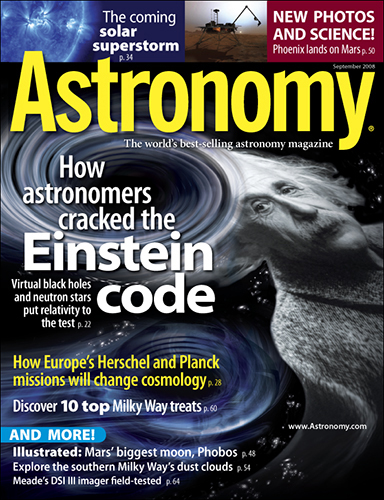
More resources from Astronomy.com:
- Astronomy news
- Astronomy basics
- Glossary of astronomical terms
- Return to Astronomy “For the media” page
Astronomy‘s mission:
Astronomy promotes the science and hobby of astronomy through high-quality publications that engage, inform, entertain, and inspire.
WAUKESHA, Wis. — Catch a glimpse of Mercury, Venus, and Mars in conjunction in September. The three planets lie in the constellation Virgo the Maiden early in the month.
Venus serves as a beacon, highlighting the two fainter planets in bright twilight September 11. Mars and Venus stand just 0.3° apart, while Mercury lies less than 5° away from the two. A fist held at arms’ length is equal to 10 degrees. The conjunction is visible to the naked eye, but it will be seen best through binoculars.
The September night sky also offers a naked-eye view of Uranus on the 12th when the planet reaches opposition.
Pick up the September issue of Astronomy for observing tips and to see a map of the night sky.
“The coming solar superstorm”
In 1859, the Sun let loose the biggest superstorm in 450 years. The blast of the solar flares from the 1859 superstorm could today cripple much of the technology we rely on. Data indicate another superstorm could occur in the next few years. In “The coming solar superstorm,” Sten Odenwald, professor of astronomy at Catholic University in Washington, reveals the science behind predicting these superstorms and explains how we can prepare for them.
“Any disaster capable of causing large-scale blackouts, disrupting communications networks, and damaging satellites is something to prepare for,” Odenwald says.
“How astronomers cracked the Einstein code”
Scientists have wrestled with Einstein’s theory of relativity for years. Today, they use computer simulations to merge black holes and put relativity to the test. In “How astronomers cracked the Einstein code,” Adam Frank explains how astronomers apply Einstein’s theory of relativity to black holes’ gravity.
“NASA’s Phoenix digs Mars”
The Phoenix lander, Mars newest spacecraft, is busy digging beneath the surface of the Red Planet, analyzing soil samples, and discovering evidence of ice. “NASA’s Phoenix digs Mars,” by Bruce Moomaw, discusses what we’ve learned from Phoenix and showcases the new images from the lander.
Also in the September 2008 Astronomy
- “Discover 10 top Milky Way delights” — From Sagittarius to Cassiopeia, late summer offers a lot to observe.
- “Illustrated: Meteors rock Phobos” — Mars’ largest moon bears scars from loads of major impacts.
- “Europe’s space revolution” — How the Herschel and Planck missions will change cosmology.
- The September issue of Astronomy also includes Astro news, Bob Berman’s Strange universe, Glenn Chaple’s Observing basics, Phil Harrington’s Binocular universe, Stephen James O’Meara’s Secret sky, New products, and Reader gallery.









